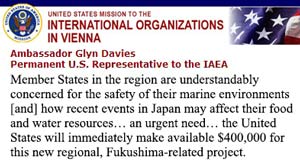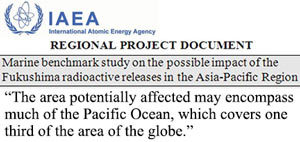|
Marshall Islands Journal, Jul 18, 2014 (emphasis added): Seawater check for radioactivity… the International Atomic Energy Agency (IAEA) visited the Marshall Islands earlier this month to train local officials to sample seawater for radioactive cesium… the IAEA Project [is] called “Marine benchmark study on the possible impact of the Fukushima radioactive releases in the Asia-Pacific Region.”… During a field exercise on July 2, two sets of seawater samples were collected… The samples were collected on filter cartridges coated with chemicals that will bond to the cesium element… This is the start of monitoring Marshall Islands seawater for cesium radioactivity which will be carried out every three months…
 IAEA Board of Governors Meeting, Ambassador Glyn Davies, Permanent U.S. Representative to the IAEA, 2011: Today the Secretariat has presented to us a new Technical Cooperation project entitled “Marine benchmark study on the possible impact of the Fukushima radioactive releases in the Asia-Pacific Region.”… Member States in the region are understandably concerned for the safety of their marine environments. The IAEA has unique expertise to offer in helping them to assess how recent events in Japan may affect their food and water resources… The United States fully supports this project… While the Secretariat has demonstrated admirable flexibility and agility in assembling this project quickly to meet anurgent need, we recognize… extra-budgetary resources are required… My delegation is pleased to announce that the United States will immediately make available $400,000 for this new regional, Fukushima-related project… We hope this contribution will allow the project to move forward without delay… IAEA Board of Governors Meeting, Ambassador Glyn Davies, Permanent U.S. Representative to the IAEA, 2011: Today the Secretariat has presented to us a new Technical Cooperation project entitled “Marine benchmark study on the possible impact of the Fukushima radioactive releases in the Asia-Pacific Region.”… Member States in the region are understandably concerned for the safety of their marine environments. The IAEA has unique expertise to offer in helping them to assess how recent events in Japan may affect their food and water resources… The United States fully supports this project… While the Secretariat has demonstrated admirable flexibility and agility in assembling this project quickly to meet anurgent need, we recognize… extra-budgetary resources are required… My delegation is pleased to announce that the United States will immediately make available $400,000 for this new regional, Fukushima-related project… We hope this contribution will allow the project to move forward without delay…
IAEA Technical Cooperation Programme 2011–15: Marine benchmark study on the possible impact of the Fukushima radioactive releases in the Asia-Pacific Region… thisradioactive contamination could be transported and circulated through the Pacific Ocean… Member States have expressed concern about the possible impact of these releases on their coastal zones… Anurgent and harmonised regional approach is essential… The area potentially affected may encompass much of the Pacific Ocean, which covers one third of the area of the globe.
 IAEA Coordinated Research Activities in 2014–2015 (pdf): Benchmark Ocean Models for the Dispersion and Radiological Impact of Released Radionuclides from the Fukushima Daiichi Nuclear Power Plant – The accident at the Fukushima Daiichi nuclear power plant released huge amounts of radioactive substances into the Pacific Ocean. These radionuclides will be transferred and dispersed over the Pacific Ocean during the next years. There are a number of different ocean dispersion models to predict the dispersion of pollutants… and uptake in biota and to assess the potential radiation exposure to humans and the environment… The predictions can be used for recommendations for the Pacific Member States for measures with regard to seafood consumption or export or import of marine food… IAEA Coordinated Research Activities in 2014–2015 (pdf): Benchmark Ocean Models for the Dispersion and Radiological Impact of Released Radionuclides from the Fukushima Daiichi Nuclear Power Plant – The accident at the Fukushima Daiichi nuclear power plant released huge amounts of radioactive substances into the Pacific Ocean. These radionuclides will be transferred and dispersed over the Pacific Ocean during the next years. There are a number of different ocean dispersion models to predict the dispersion of pollutants… and uptake in biota and to assess the potential radiation exposure to humans and the environment… The predictions can be used for recommendations for the Pacific Member States for measures with regard to seafood consumption or export or import of marine food…
IAEA Coordinated Research Activities in 2015 (pdf): Benchmark Ocean Models for the Dispersion and Radiological Impact of Radionuclides Released from Nuclear Power Plants in Emergency Situations… These radionuclides are being dispersed and transferred through the ocean, and numerous studies of these processes have been carried out… to predict the behaviour of the radionuclides and, further on, to estimate doses to biota and human populations… The Fukushima discharges will be used as a benchmark study for the Pacific Ocean. The simulated data will be compared with actual measurement results…
See also: Paper: IAEA to monitor radioactive substances 7,000 km from Fukushima
|